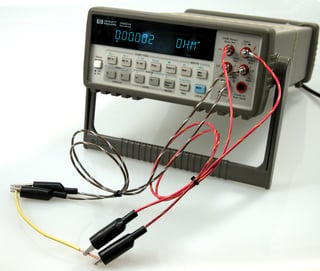Test engineers need more precise tests as technology becomes more complicated. One of the ways to get a more precise resistance measurement is through 4-wire Kelvin testing.
Resistance refers to the limitation of current through a wire. To measure resistance, send a current through the wire, measure how much the voltage drops, and calculate the resistance (Ohm’s Law: Resistance = Voltage / Current). You can determine this measurement using an ohmmeter.
An ohmmeter has two test leads that connect to the wire and measure the resistance. These test leads both send a current and measure the resistance. Because the leads are connected to the current source and the voltmeter, there is no way to measure the resistance of the device-under-test without including the resistance of the test leads.
If your resistance test doesn’t require a precise measurement, a 2-wire ohmmeter is more than capable of performing a resistance test. It will let you know that current is flowing through the wire. However, if you have a test that requires an accurate resistance measurement, you will need a more precise test method.
Four-wire Kelvin testing provides a more accurate resistance measurement. Instead of using two test leads, the ohmmeter has four leads connected to the DUT. Two of the leads come from the current source (sometimes referred to as the “force” leads) and the other two come from the voltmeter (referred to as the “sense” leads). The force leads send the current and the sense leads measure the resistance of the DUT. The measurement can be so precise
You can perform 4-wire testing with using ohmmeters as well as automated testers. Now that you understand why 4-wire Kelvin testing is used in resistance testing, learn how to perform 4-wire testing using your Cirris tester. Click the link to for an article and video discussing 4-wire Kelvin testing and Cirris testers.

Further Reading:
Resistance Is NOT Futile
The Novice’s Guide to Purchasing a Cable Tester
3 Ways to Set Yourself Up for Wiring Errors